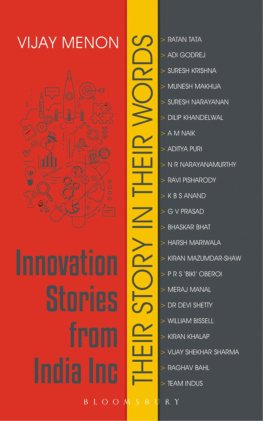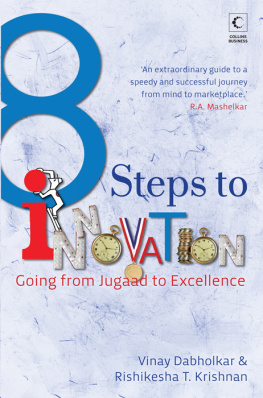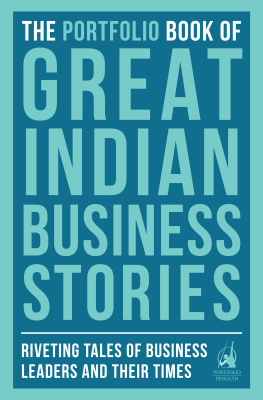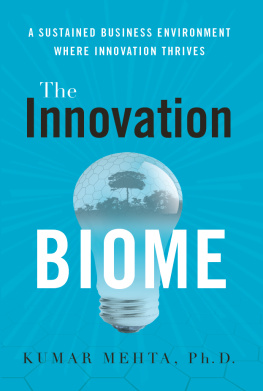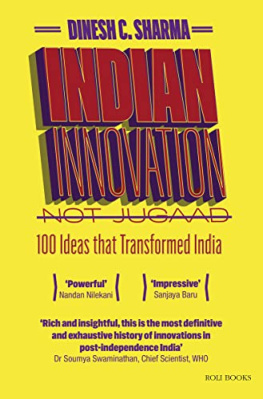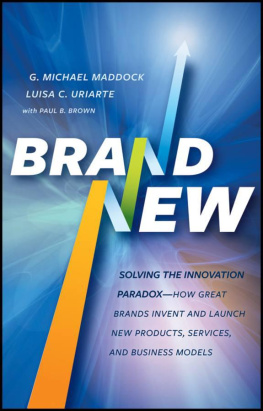Content

Innovation Stories from India Inc:
Their Story in Their Words
Innovation Stories from India Inc:
Their Story in Their Words
Vijay Menon

First published in India 2017
2017 by Vijay Menon
All rights reserved. No part of this publication may be reproduced or transmitted in any form or by any means, electronic or mechanical, including photocopying, recording, or any information storage or retrieval system, without prior permission in writing from the publishers.
No responsibility for loss caused to any individual or organization acting on or refraining from action as a result of the material in this publication can be accepted by Bloomsbury or the author.
The content of this book is the sole expression and opinion of its author, and not of the publisher. The publisher in no manner is liable for any opinion or views expressed by the author. While best efforts have been made in preparing this book, the publisher makes no representations or warranties of any kind and assumes no liabilities of any kind with respect to the accuracy or completeness of the content and specifically disclaims any implied warranties of merchantability or fitness of use for a particular purpose.
The publisher believes that the content of this book does not violate any existing copyright/intellectual property of others in any manner whatsoever. However, in case any source has not been duly attributed, the publisher may be notified in writing for necessary action.
BLOOMSBURY and the Diana logo are trademarks of Bloomsbury Publishing Plc
E-ISBN 978 93 86432 70 4
2 4 6 8 10 9 7 5 3 1
Bloomsbury Publishing India Pvt. Ltd
Second Floor, Building No.4
DDA Complex LSC, Pocket C 6 & 7
Vasant Kunj, New Delhi 110070
www.bloomsbury.com
Created by Manipal Digital Systems
To find out more about our authors and books visit www.bloomsbury.com.
Here you will find extracts, author interviews, details of forthcoming events and the option to sign up for our newsletters.
To Anitha, wife and Meghna, daughter. May the conversations be
always interesting.
We constantly hear about innovation in Silicon Valley, Europe, South Korea, and other places. The stories about companies like Apple, IKEA, and Samsung are fascinating and interesting. But we dont get to hear too many stories about innovation in India Inc.
And yet, most of us can recall instances of being part of a creative flow. In my career as an engineer, journalist, and marketing leader, I have been part of several innovative initiatives. See the Appendix for a representative couple.
So in the summer of 2016, I went looking for stories of innovation at Indian workplaces. I met the leaders at a cross-section of Indian conglomerates, standalone companies, the Indian arm of MNCs, and startups. Over one-to-one conversations, these business leaders told me stories of product, process, and management innovations in their companies.
This book is the result of that journey. The stories here are real-life examples of how companies in India have innovated to forge ahead. Barring one, each story is crafted in two parts: an introduction to set the context followed by the companys innovation story in its leaders words.
The storytellers are some of India Incs finest business leaders and Ive tried to retain their distinctive voice. To preserve authenticity, I transcribed the interviews, edited them into a narrative, and filled gaps with supplementary research. I sent the resulting story to the interviewee in every case for a fact check. The result, I hope, is authentic and engaging.
So find a quiet spot, put your phone on silent, and turn the page. Fascinating journeys await.
A book like this that involved meeting several business leaders was always going to be challenging. Getting past the gate keepers was difficult with rare exceptions. So Im deeply thankful to everyone who made the book possible: the leaders for their courtesy, time, and candidness; the corporate communication teams and executive assistants for setting up the meetings and vetting the resulting story; friends who helped with a contact or a suggestion; and my family, who were always patient sounding boards and critics. A big thank you also to Nitin Valecha and the team at Bloomsbury, without whom, of course, this book would have never been published.
In addition to the people named in the stories, these are the people, in alphabetical order, who helped make the book possible. Thank you. Im very grateful.
A G Pandu
Akshatha TN
Anand Halve
Antaash Sheikh
Arjun Mukundan
Arup Mukherjee
Ashmita Pillay
Aviral and Aparna Khandelwal
C Vinayaraghavan
Calvin Printer
Deepak Morada
Dilnaz Gilder
Dipika Mohil
Drs Ashwini and Chitra Setya
Jayanth Nanjappa
Lata Sharma
Madhavan Varadharajan
Manoj Menon
P V G Menon
Pani Nagaraja
Premila Vaz
Priyanka Jha
R Parthasarathy
Rakesh Sinha
Rathnam Subramanyam
Rita Srivastava
Ritu Kalia
Rowena Carneiro
Rubina DSilva
Sarika Kapoor Chokshi
Sarmishta Nandakumar
Sheelika Ravishankar
Sherna DMello
Sonia Dhawan
Sreeram Venkiteswaran
Sriram Gopalakrishnan
Tanuj Kumar
Tenzin Dechen Deshar
Contents
Epic. Thats the word that comes to mind when writing about Ratan Tata, chairman of Tata Sons, the holding company of the Tata group (FY16 revenue $103 billion) for twenty-one years from 1991 to 2012, and interim chairman from October 2016 to January 2017. Tata, a conglomerate of some 100-odd companies, is Indias largest business group and active in a wide array of industries from fashion to steel to automotive to software.
Ratan Tata (born 1937), returned to India in 1962 after graduating from Cornell University with a degree in architecture and working briefly with a Los Angeles-based architecture firm. He joined the family business and spent several years rotating through different roles and companies before being appointed chairman in 1991.
The initial years of his stewardship were mostly spent in consolidating his position and overcoming resistance from the old order in group companies. The second decade of Tatas leadership was marked by several big-ticket acquisitions as the group expanded and globalized on the back of economic liberalization and a rapidly-growing Indian economy. The notable buys were $450 million for UKs Tetley Tea, Rs 1591 crore for Indias VSNL, $365 million for Singapores NatSteel, $11.3 billion for Anglo-Dutch steel maker Corus, $2.3 billion for vehicle maker Jaguar Land Rover, and $1 billion for US-based General Chemical Industrial Products.
Going by the numbers, the Tata group under Ratan Tata grew at a compounded annual growth rate of about 22 per cent in both revenue and profit, a creditable achievement by any standard in large groups. From a financial standpoint, his big decisions have had mixed results. The UK operations of Corus steel turned unviable when the commodity cycle turned and cheap Chinese imports flooded the market. His pet project, the Nano, promoted as the worlds cheapest car, sells in very low volumes. But Jaguar Land Rover is doing very well and the software business is thriving.
But the numbers dont tell the full story. Ratan Tata strides the Indian business landscape like a colossus. The acquisitions of Jaguar Land Rover and Corus steel not only heightened Indian self-esteem, they also brought Indian companies and brands on the international stage. At home, the Nano car project fired public imagination; and Tata Consultancy Services (TCS), along with other software companies, made India the IT services outsourcing capital of the world.

